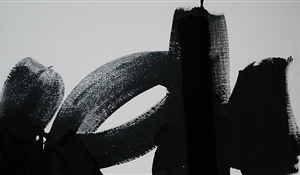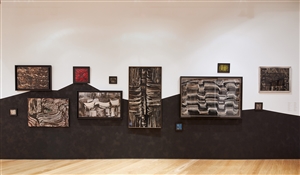Interview with Ali Nasir About His Solo Shows in Autumn of 2021
19 Jun 2022Ali Nasir's artworks were simultaneously displayed in two solo exhibitions in Iran in November and December 2021. His drawings and paintings dating back to the 1980s and 1970s were displayed as "Project re-presentaion-1" at 009821 Projects Gallery from December 17 to 28 with Iman Safaei as curator. Another part of Nasir's artworks, created between 2019 to 2021, were displayed in a solo show at O Gallery. So we talked to Ali Nasir about his artistic life and career path. This interview has been conducted in December 2021.

Ali Nasir | Installation View | O Gallery
-
What is the subject and the basic idea of this exhibition?
There is no specific subject or title for this exhibition, but it is somehow along with my previous show. It has been a while since I have ceased to follow figurative art principles and have developed a tendency towards abstract art. Additionally, the pourings, tonalities and brushstrokes in my works reflect the social issues and mental moods that I have been experiencing.
During the pandemic, I found enough time to review my previous works and I also had the opportunity to read the art history again. I am personally interested in the Renaissance period and some of my works displayed in this exhibition may refer to some artworks of that era; for instance, "Judith Beheading Holofernes" by Caravaggio and works by Artemisia Gentileschi. Death is also another subject represented in one of my huge works displayed here. So the two works I just mentioned are different in subject from the rest of my works in this exhibition. I have created them recently and I am not sure yet how I will proceed in this direction.
-
There are more artworks in this show than the previous one and the gallery's space is fully occupied. Why is that?
There is yet another exhibition over there (009821 Projects Gallery) [he laughs]. There is no specific reason behind the number of displayed artworks. There were simply many artworks and Miss Orkideh Daroodi [manager of the O Gallery] suggested presenting all of them in the two floors of the gallery.
-
Compared to your previous shows, what properties, moods, and subjects do you want the visitors to experience here?
The first thing to notice is the visual variation created in these works. These variations are related to the tonalities and compositions. Tonalities have changed fundamentally compared to my previous works and this has consequently affected the compositions. However, my overall framework is still in accordance with my previous aesthetic principles. I am not concerned with what the viewer should discover here. I have no idea what they will discover when looking at my works. Nevertheless, compared to the previous show, this exhibition seems more mature in aesthetic aspects. This one is more expressive and complete.

Ali Nassir | Untitled | mixed materials on paper | 40 × 30 cm
-
You mentioned that your previous figurative style of painting has faded away in your recent work and that their visual forms have differed.
Works displayed here fall into two categories. [For the first part], as I said, I have recently referred to some outstanding classic artworks of the ancient past. In the works inspired by the Renaissance art period, figurative style is more obviously visible. The other part, however, is created along with my previous show in which I used less figurative forms. In these works, the figure is either not visible, or hardly visible.
-
Why is that?
I have always shifted between figurative and abstract styles. The conflict between them has always been attractive to me. This [shifting] attitude [between figurative and abstract] has been around since the 1980s. In fact, it has always been around, but the focus on each of them varies over the years. In this show, both are presented. In other words, the visual appearance of these artworks is dominated either by abstract or figurative forms; though I don't see much difference between them.
-
Compared to your previous shows, as you said, you think this one is more developed and mature. What we normally ask is why should an audience come to visit the exhibition?
Your question is not clear to me. I think art audiences should visit this show and many other shows as well; unfortunately, I don't get what you mean.
-
How would you define the painting itself? As an artist, you have spent many years in art and painting. Now looking back at your experiences, how would you define painting in a short explanation? And what is the position of painting in your career path?
I cannot define painting, but about its position for me, I should say that most of my life is dedicated to painting. Painting is my profession, my work, my passion, and everything. This is the importance of painting in my life. I wake up eager to paint, so I go to my workshop and focus on painting for long hours. I start at 8 in the morning, and stop at about 7 or 8 in the evening.
So this is the position I perceive about painting in my life, but I cannot give you a definition. There are some stereotypical definitions that present painting as this or that, but I really don't approve of them. Certainly, painting has its unique definition in my mind, but I can't explain it in words.






